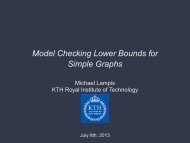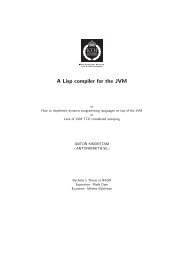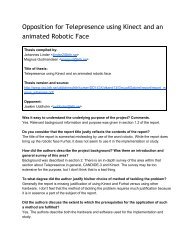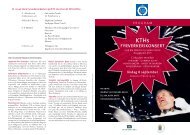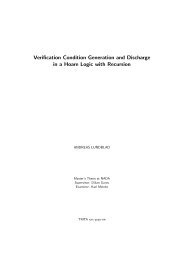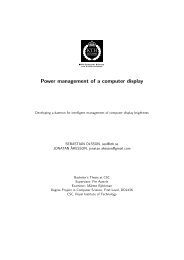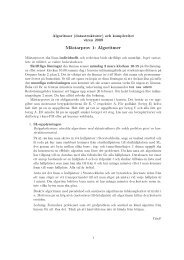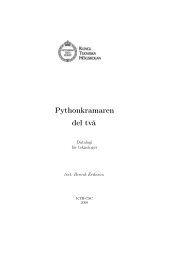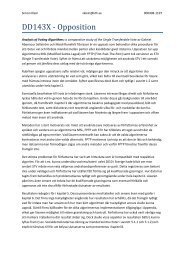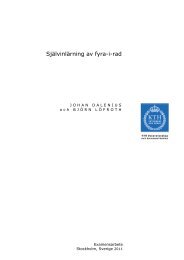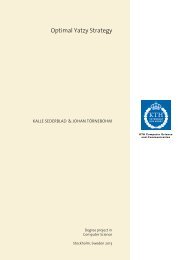Questions?
Questions?
Questions?
You also want an ePaper? Increase the reach of your titles
YUMPU automatically turns print PDFs into web optimized ePapers that Google loves.
Information Flow Security<br />
DD2460 Software Safety and Security: Part III, lecture 1<br />
Gurvan Le Guernic<br />
DD2460 (III, L1)<br />
February 14 th , 2012
CONTEXT FORMALIZATION CHANNELS, FLOWS AND LABELS WRAP-UP<br />
Outline<br />
Information Flow Security deals with Confidentiality and Integrity related<br />
security policies.<br />
1 Context<br />
2 Formalization<br />
3 Channels, Flows and Labels<br />
4 Wrap-up<br />
G. Le Guernic DD2460 (III, L1): Information Flow Security 2/35
CONTEXT FORMALIZATION CHANNELS, FLOWS AND LABELS WRAP-UP<br />
Context<br />
G. Le Guernic DD2460 (III, L1): Information Flow Security 3/35
CONTEXT FORMALIZATION CHANNELS, FLOWS AND LABELS WRAP-UP<br />
Context<br />
More and more information systems (PC, smartphone,<br />
web browser, server, . . . ) inhabited by applications<br />
and data belonging to different “owners”.<br />
Problem: untrusted applications living in the same<br />
space as sensitive data (sometimes even manipulating<br />
them).<br />
Same problem for every system manipulating code<br />
and/or data with different end-user access rights<br />
ads in websites<br />
cross-site scripting<br />
. . .<br />
G. Le Guernic DD2460 (III, L1): Information Flow Security 4/35
CONTEXT FORMALIZATION CHANNELS, FLOWS AND LABELS WRAP-UP<br />
What’s the big deal?<br />
G. Le Guernic DD2460 (III, L1): Information Flow Security 5/35
CONTEXT FORMALIZATION CHANNELS, FLOWS AND LABELS WRAP-UP<br />
Question!<br />
What security policy do you want for your own connected<br />
devices (smartphone, PC, tablet, . . . ) in general?<br />
What policy with regard to your contacts data in particular?<br />
G. Le Guernic DD2460 (III, L1): Information Flow Security 6/35
CONTEXT FORMALIZATION CHANNELS, FLOWS AND LABELS WRAP-UP<br />
Deployed techniques: Trust<br />
Download and/or execute only from trusted sources<br />
G. Le Guernic DD2460 (III, L1): Information Flow Security 7/35
CONTEXT FORMALIZATION CHANNELS, FLOWS AND LABELS WRAP-UP<br />
Deployed Techniques: Access Control<br />
restrict data accessible by a software<br />
if it can only access public data then it can<br />
only output public data<br />
Allows enforcing least privilege<br />
Definition 1 (Least Privilege Principle)<br />
Every entity (process, user, program, . . . )<br />
should own the least set of privileges<br />
(information and resources access right) that is<br />
necessary for its legitimate purpose.<br />
Saltzer & Schroeder 1975<br />
G. Le Guernic DD2460 (III, L1): Information Flow Security 8/35
CONTEXT FORMALIZATION CHANNELS, FLOWS AND LABELS WRAP-UP<br />
Question!<br />
Are your own security policies enforceable using those<br />
mechanisms (trust & access control)?<br />
G. Le Guernic DD2460 (III, L1): Information Flow Security 9/35
CONTEXT FORMALIZATION CHANNELS, FLOWS AND LABELS WRAP-UP<br />
Information Flow Security: philosophy<br />
Problem: What about all those Android applications<br />
that ask for many privileges?<br />
Philosophy:<br />
trust and/or access control are not<br />
sufficient<br />
analyze/track information flows<br />
prevent data leaks and/or tempering<br />
G. Le Guernic DD2460 (III, L1): Information Flow Security 10/35
CONTEXT FORMALIZATION CHANNELS, FLOWS AND LABELS WRAP-UP<br />
Secure Information Flows<br />
Definition 2 (Secure Information Flows: confidentiality)<br />
A process is said to contain only secure information flows, wrt confidentiality,<br />
if and only if an attacker is unable to deduce information about the secret<br />
(hidden) data by looking only at the publicly observable (leaked) outputs of<br />
the process.<br />
private input<br />
public input<br />
program<br />
as a function :<br />
:<br />
output :<br />
? ? ? ? ? ?<br />
G. Le Guernic DD2460 (III, L1): Information Flow Security 11/35
CONTEXT FORMALIZATION CHANNELS, FLOWS AND LABELS WRAP-UP<br />
Software Information Flow Security<br />
Study a program to decide if its executions respects the confidentiality of<br />
secret data and the integrity of sensitive data.<br />
For software information flow security, attacker is usually assumed to:<br />
know the program code<br />
have a partial view of/control over the execution<br />
Noninterference:<br />
Cohen (77), Goguen and Meseguer (82)<br />
Property of a program having only good information flows<br />
Hidden/Hacked inputs do not influence Leaked/Legitimate outputs<br />
No (data/control) flow from H to L<br />
G. Le Guernic DD2460 (III, L1): Information Flow Security 12/35
CONTEXT FORMALIZATION CHANNELS, FLOWS AND LABELS WRAP-UP<br />
Formalization<br />
G. Le Guernic DD2460 (III, L1): Information Flow Security 13/35
CONTEXT FORMALIZATION CHANNELS, FLOWS AND LABELS WRAP-UP<br />
Strong Dependency<br />
Definition 3 (Strong Dependency)<br />
There exists an information flow from input i to output o in a process �<br />
whenever variety in i is conveyed to o by the execution of �.<br />
“information is transmitted from a source to a destination only when<br />
variety in the source can be conveyed to the destination”<br />
E. S. Cohen, “Information Transmission in Computational Systems”, 1977<br />
For deterministic processes, o is strongly dependent on i if and only if there<br />
exist at least two executions of � whose inputs differ only in i and whose<br />
outputs differ in o.<br />
⇒ The process � carried over the initial variety in i to the output o.<br />
G. Le Guernic DD2460 (III, L1): Information Flow Security 14/35
CONTEXT FORMALIZATION CHANNELS, FLOWS AND LABELS WRAP-UP<br />
Noninterference<br />
Noninterference = absence of strong dependency from H<br />
(hidden/hacked) inputs to L (leaked/legitimate) outputs.<br />
Definition 4 (Noninterference)<br />
A program is said to be noninterfering if and only if any executions, started<br />
with the same L (leaked/legitimate) inputs, generate the same L<br />
(leaked/legitimate) outputs.<br />
G. Le Guernic DD2460 (III, L1): Information Flow Security 15/35
CONTEXT FORMALIZATION CHANNELS, FLOWS AND LABELS WRAP-UP<br />
Noninterference: in picture<br />
Allowed Information Flows<br />
A process is said to be noninterfering if the values of its L (leaked/legitimate)<br />
outputs depend only on the values of its L (leaked/legitimate) inputs.<br />
H inputs<br />
L inputs<br />
Process �<br />
H outputs<br />
L outputs<br />
G. Le Guernic DD2460 (III, L1): Information Flow Security 16/35
CONTEXT FORMALIZATION CHANNELS, FLOWS AND LABELS WRAP-UP<br />
Noninterference: in Greek letters<br />
Definition 5 (Noninterference)<br />
A program � is noninterfering if and only if any two executions, started in<br />
execution environments (σi) having the same L (leaked/legitimate) values,<br />
generate the same L (leaked/legitimate) observations (O[[σi ⊢ �]]).<br />
∀σ1,σ2 : σ1 =L σ2 ⇒ O[[σ1 ⊢ �]] = O[[σ2 ⊢ �]]<br />
In non-deterministic case, O[[σ1 ⊢ �]] can be:<br />
set of all possible observations<br />
→ possibilistic noninterference<br />
mapping from all possible observations to probability<br />
→ probabilistic noninterference<br />
G. Le Guernic DD2460 (III, L1): Information Flow Security 17/35
CONTEXT FORMALIZATION CHANNELS, FLOWS AND LABELS WRAP-UP<br />
Channels, Flows and Labels<br />
G. Le Guernic DD2460 (III, L1): Information Flow Security 18/35
CONTEXT FORMALIZATION CHANNELS, FLOWS AND LABELS WRAP-UP<br />
Card Game<br />
0|1 ! 0|1 ?<br />
G. Le Guernic DD2460 (III, L1): Information Flow Security 19/35<br />
�
CONTEXT FORMALIZATION CHANNELS, FLOWS AND LABELS WRAP-UP<br />
Information �= Data<br />
Information �= Data<br />
A piece of data carries more information than its intrinsic value.<br />
“the information carried by a particular message depends on the<br />
set it comes from. The information conveyed is not an intrinsic<br />
property of the individual message.”<br />
W. R. Ashby, “An Introduction to Cybernetics”, 1956.<br />
“Everything is fine!” does not convey the same information if it comes from:<br />
someone in vacations,<br />
someone starting a new job,<br />
a prisoner in a dictatorship.<br />
G. Le Guernic DD2460 (III, L1): Information Flow Security 20/35
CONTEXT FORMALIZATION CHANNELS, FLOWS AND LABELS WRAP-UP<br />
Information Channels<br />
Lampson (“A Note on the Confinement Problem”, 1973) defines 3 types of information channels:<br />
Legitimate channels:<br />
use mechanisms intended for legitimate data transfer<br />
example: Internet communication for web browser<br />
Storage channels:<br />
2 steps transfer using data storage (not transfer) mechanisms<br />
goal: delaying in time and space the realization of the undesired flow<br />
Bell-LaPadula’s ⋆-property (aka “no write-down”/confinement property) aims at<br />
reducing such channels usage for access control mechanisms<br />
Covert channels:<br />
use mechanisms not intended for data manipulation (transfer, computation or storage)<br />
encode information into visible side effects of legitimate (potentially transfer)<br />
mechanisms<br />
example: file locks, computation time/consumption, program counters, . . . (A♠)<br />
G. Le Guernic DD2460 (III, L1): Information Flow Security 21/35
CONTEXT FORMALIZATION CHANNELS, FLOWS AND LABELS WRAP-UP<br />
Information Flows<br />
Two dimensions: direct/indirect and explicit/implicit<br />
direct: use legitimate channels intended for data transfer.<br />
indirect: use channels which are not intended for data transfer.<br />
explicit: created by the occurrence of a specific event.<br />
implicit: created by the fact that a specific event does not occur.<br />
�<br />
Some papers (particularly static techniques) use:<br />
direct or explicit for direct flows<br />
indirect or implicit for indirect flows<br />
G. Le Guernic DD2460 (III, L1): Information Flow Security 22/35
CONTEXT FORMALIZATION CHANNELS, FLOWS AND LABELS WRAP-UP<br />
Information Flows: example<br />
Explicit<br />
created by the<br />
occurrence of an<br />
event/action<br />
Implicit<br />
created by the absence<br />
of a specific event/action<br />
if b then x := e1 else y := e2<br />
Direct<br />
use legitimate channels for data<br />
transfer<br />
e 1 → x iff b = true<br />
e 2 → y iff b = false<br />
Indirect<br />
use channels not intended for data<br />
transfer<br />
b → x iff b = true<br />
b → y iff b = false<br />
b → y iff b = true<br />
b → x iff b = false<br />
G. Le Guernic DD2460 (III, L1): Information Flow Security 23/35
CONTEXT FORMALIZATION CHANNELS, FLOWS AND LABELS WRAP-UP<br />
Security Labels<br />
Security labels:<br />
confidentiality and/or integrity levels<br />
form a preorder (reflexive and transitive relation)<br />
(L, ≤)<br />
Security lattice:<br />
labels may form a lattice<br />
preorder with unique least upper-bound (aka lub or join) and greatest<br />
lower-bound (aka glb or meet) for any 2 labels<br />
(L, ≤, ⊔, ⊓)<br />
lub: ∀l1l2. li ≤ (l1 ⊔ l2) and ∀l3. li ≤ l3 ≤ (l1 ⊔ l2) ⇒ l3 = (l1 ⊔ l2)<br />
glb: ∀l1l2. (l1 ⊔ l2) ≤ li and ∀l3. (l1 ⊓ l2) ≤ l3 ≤ li ⇒ l3 = (l1 ⊓ l2)<br />
top: ∀l. l ≤ ⊤<br />
bottom: ∀l. ⊥ ≤ l<br />
G. Le Guernic DD2460 (III, L1): Information Flow Security 24/35
CONTEXT FORMALIZATION CHANNELS, FLOWS AND LABELS WRAP-UP<br />
Security Labels: examples (1)<br />
Alice’s<br />
secret<br />
Top secret<br />
Public<br />
Bob’s<br />
secret<br />
Confidentiality<br />
A = Alice’s secret<br />
⊥ = Public<br />
A ⊔ ⊥ = A<br />
Trusted<br />
by Alice<br />
Fully trusted<br />
Untrusted<br />
Integrity<br />
A = Trusted by Alice<br />
B = Trusted by Bob<br />
A ⊓ B = Untrusted<br />
Trusted<br />
by Bob<br />
G. Le Guernic DD2460 (III, L1): Information Flow Security 25/35
CONTEXT FORMALIZATION CHANNELS, FLOWS AND LABELS WRAP-UP<br />
Security Labels: use<br />
Containers (variables, files, . . . ) are assigned a label:<br />
statically or dynamically set<br />
at write: verify that data’s label is less secret (resp. more trusted) than<br />
container’s label<br />
at read: consider container’s label as a secrecy upper-bound (resp.<br />
integrity lower-bound) of data’s label<br />
G. Le Guernic DD2460 (III, L1): Information Flow Security 26/35
CONTEXT FORMALIZATION CHANNELS, FLOWS AND LABELS WRAP-UP<br />
Security Labels: examples (2)<br />
RA<br />
RA ∩ RB<br />
RA ∪ RB<br />
RB<br />
⊤<br />
⊥<br />
ACL security lattice<br />
(confidentiality)<br />
RA: set of allowed readers<br />
Untainted<br />
Tainted<br />
Perl Security Lattice<br />
(Integrity)<br />
G. Le Guernic DD2460 (III, L1): Information Flow Security 27/35
CONTEXT FORMALIZATION CHANNELS, FLOWS AND LABELS WRAP-UP<br />
From Security Lattice to Flow Lattice<br />
Flow lattice:<br />
describes allowed information flows: x := y iff ly ≤ lx<br />
Flow lattice = confidentiality lattice × inverse of integrity lattice<br />
�<br />
Some always talk about integrity lattice in inverse mode<br />
Trusted ≤ Untrusted<br />
G. Le Guernic DD2460 (III, L1): Information Flow Security 28/35
CONTEXT FORMALIZATION CHANNELS, FLOWS AND LABELS WRAP-UP<br />
From Security Lattice to Flow Lattice<br />
⎛<br />
⎜<br />
⎝<br />
Secret<br />
Public<br />
Trusted<br />
Untrusted<br />
⎞<br />
⎟<br />
⎠<br />
→<br />
−1<br />
→<br />
Secret<br />
Public<br />
Untrusted<br />
Trusted<br />
G. Le Guernic DD2460 (III, L1): Information Flow Security 29/35
CONTEXT FORMALIZATION CHANNELS, FLOWS AND LABELS WRAP-UP<br />
From Security Lattice to Flow Lattice<br />
Secret<br />
Public<br />
×<br />
⎛<br />
⎜<br />
⎝<br />
Trusted<br />
Untrusted<br />
⎞<br />
⎟<br />
⎠<br />
−1<br />
→<br />
Secret<br />
Trusted<br />
Secret<br />
Untrusted<br />
Public<br />
Trusted<br />
G. Le Guernic DD2460 (III, L1): Information Flow Security 30/35<br />
Public<br />
Untrusted
CONTEXT FORMALIZATION CHANNELS, FLOWS AND LABELS WRAP-UP<br />
Wrap-up<br />
G. Le Guernic DD2460 (III, L1): Information Flow Security 31/35
CONTEXT FORMALIZATION CHANNELS, FLOWS AND LABELS WRAP-UP<br />
6 Most Important Points<br />
IF policies = fine grain confidentiality and integrity policies<br />
Noninterference:<br />
information �= data<br />
covert channels = �<br />
∀σ1,σ2 : σ1 =L σ2 ⇒ O[[σ1 ⊢ �]] = O[[σ2 ⊢ �]]<br />
direct/indirect explicit/implicit flows<br />
Security labels form a flow lattice<br />
G. Le Guernic DD2460 (III, L1): Information Flow Security 32/35
CONTEXT FORMALIZATION CHANNELS, FLOWS AND LABELS WRAP-UP<br />
IF Workshop<br />
Goal: simulate review of existing IF security techniques<br />
Layout:<br />
group of 5 to 6 students study 1 paper (6 groups in total)<br />
presentation by randomly selected student (20-25 mn)<br />
additions/corrections by rest of the group ( 5 mn)<br />
audience questions (5-10 mn)<br />
Two levels collaboration:<br />
at the group level: deep understanding of the paper<br />
at the class level: overview of all the papers<br />
G. Le Guernic DD2460 (III, L1): Information Flow Security 33/35
CONTEXT FORMALIZATION CHANNELS, FLOWS AND LABELS WRAP-UP<br />
Grading<br />
Workshop presentation is not graded per se (report is)<br />
E:<br />
give a decent presentation (or at least additions/corrections session)<br />
be able to give an accurate summary of the paper at the course level<br />
C: (subsumes E)<br />
detail specific advantages and limitations of the paper’s technique<br />
A: (subsumes A)<br />
compare with the relevant techniques presented in the other papers<br />
G. Le Guernic DD2460 (III, L1): Information Flow Security 34/35
CONTEXT FORMALIZATION CHANNELS, FLOWS AND LABELS WRAP-UP<br />
<strong>Questions</strong>?<br />
<strong>Questions</strong>?<br />
G. Le Guernic DD2460 (III, L1): Information Flow Security 35/35



